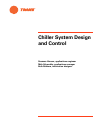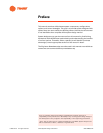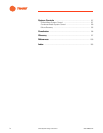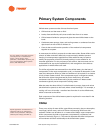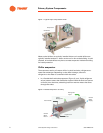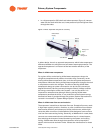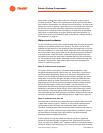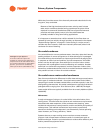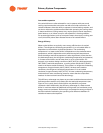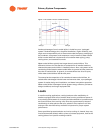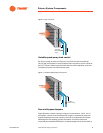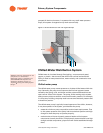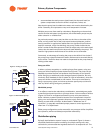
4 Chiller System Design and Control SYS-APM001-EN
Primary System Components
Some chiller controls can accommodate very little flow variation during
machine operation.
2
Other, more sophisticated, chiller controls allow some
flow variation. Some chillers can tolerate flow-rate variations—as much as 50
percent per minute or greater—while others can only tolerate up to 2 percent
per minute. It is important that chiller capabilities are matched to system
requirements. Contact the chiller manufacturer to determine the allowable
rate of flow variation before varying the flow through the evaporator in a
chiller. Flow variation is discussed in detail in the section “Variable-Primary-
Flow Systems” on page 55.
Water-cooled condenser
To cool a building or process, the transferred heat must ultimately be rejected
outdoors or to another system (heat recovery). The total amount of heat
rejected includes the sum of the evaporator load, the compressor work, and
the motor inefficiency. In a hermetic chiller, where the motor and compressor
are in the same housing, these loads are all rejected through the condenser.
In an open chiller, where the motor is separate from the compressor and
connected by a shaft, the motor heat is rejected directly to the surrounding
air. The evaporator load and the compressor work are rejected through the
condenser, and the motor heat must be taken care of by the equipment
room’s air-conditioning system.
Effect of condenser-water temperature
For a given chiller, as the leaving condenser-water temperature rises,
refrigerant temperature and pressure also rise. Conversely, as the leaving
condenser-water temperature drops, so do refrigerant temperature and
pressure. As the refrigerant pressure and temperature changes, the work a
compressor must do also changes. The effect of leaving-condenser-water
temperature change on power consumption can be 1.0 to 2.2 percent per
degree Fahrenheit [1.8 to 4.0 percent per degree Celsius]. Always consider
the energy consumption of the entire system—not just the chiller. It is
important to remember that although raising the leaving condenser-water
temperature penalizes the chiller energy, it may reduce the energy used by
the condenser pumps and cooling tower through the use of reduced flow
rates and higher thermal driving-forces on the tower. System interactions are
covered in more detail in “System Design Options” beginning on page 27.
Effect of condenser-water flow rate
The condenser is sensitive to the water flow rate. Excessive flow may result
in high water velocity, erosion, vibration, or noise, while insufficient flow
reduces heat transfer efficiency and causes poor chiller performance.
Therefore, condenser-water flow through the chiller should be kept within a
specific range of limits, except during transient startup conditions. Contact
the manufacturer for these limits. Some chillers may allow extended
operation below the selected flow rates.
If water velocity through the condenser tubes is too low for significant
periods of time and the water is extremely hard, long-term fouling of the
tubes may also occur. Webb and Li
1
tested a number of internally-enhanced
condenser tubes at low velocity (3.51 ft/s [1.07 m/s]) and high water hardness.




